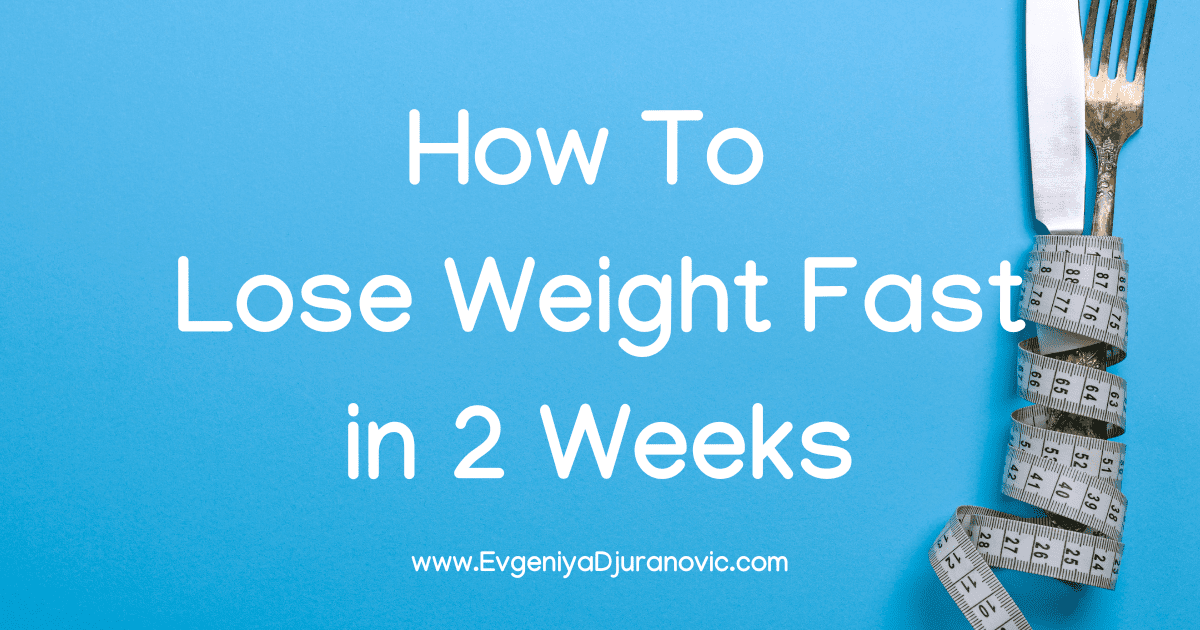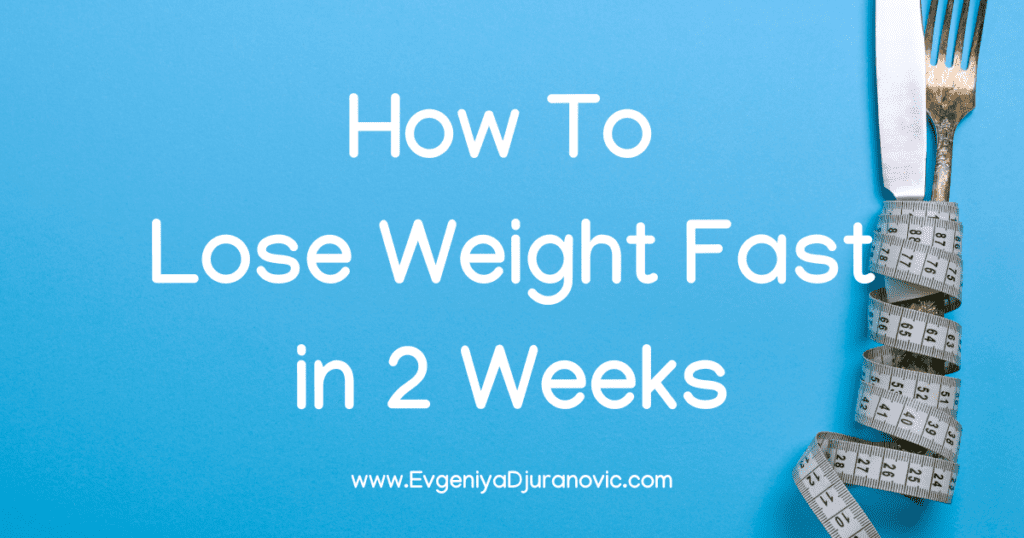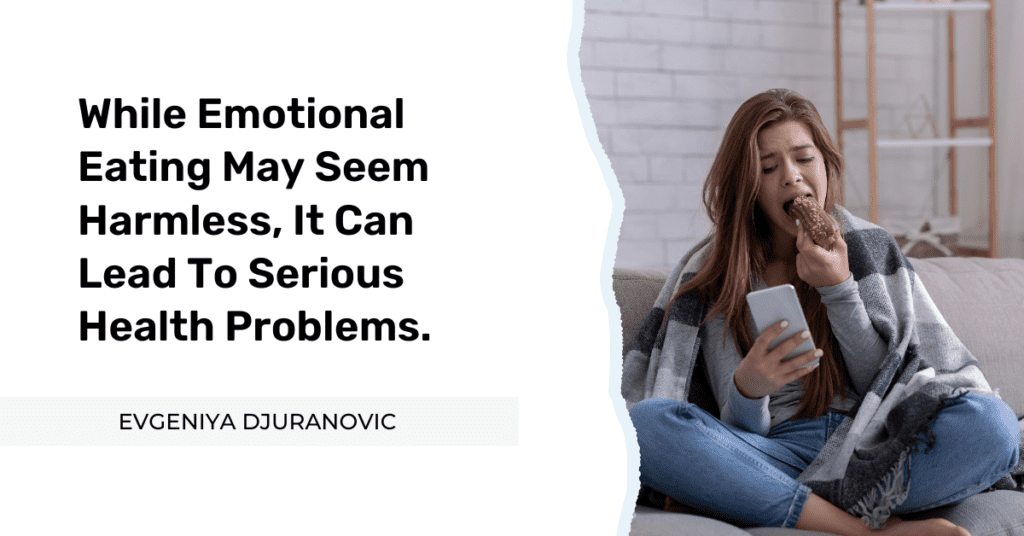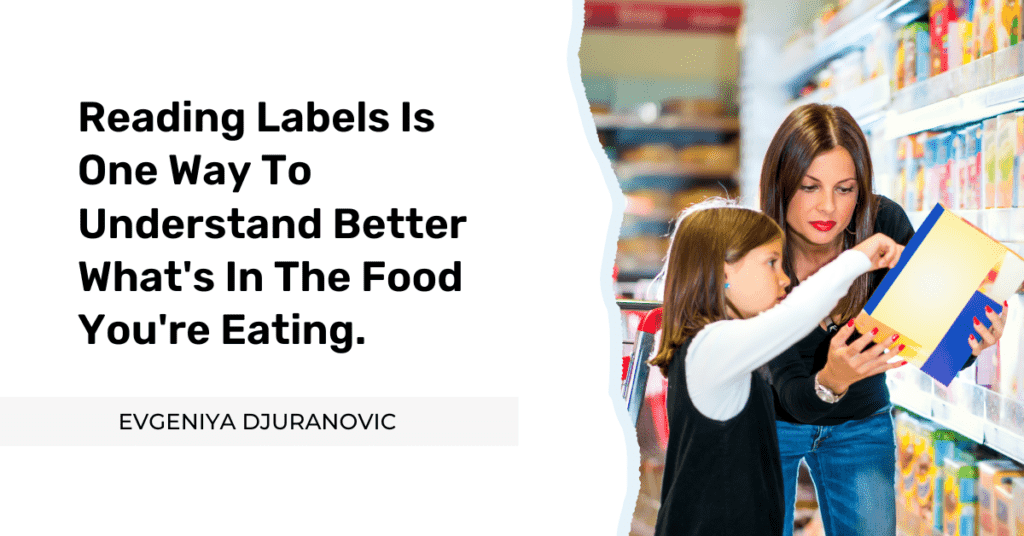How to Lose Weight Fast in 2 Weeks: 7 Steps For Success

Want to know how to lose weight fast in 2 weeks? These seven steps will set you up for success on your weight loss journey.
Losing weight fast in just two weeks is possible, but it’s not easy. You’ll need to drink plenty of water, add more nutritious meals to your diet, and pay attention to why you’re eating. Most importantly, you’ll need to take a break from unhealthy foods. Note this plan does not include lifting weights or high-intensity interval training.

How Much Weight Exactly Is Safe to Lose in 2 Weeks?
The amount of weight you can safely release in 2 weeks depends on several factors, including your starting weight and commitment to improving your health by making profound lifestyle changes and your metabolism.
Generally speaking, it’s safe for most people to lose up to 10 pounds (4.5 kg) over two weeks. However, be aware that this amount of weight loss may not be sustainable long term.
Here is the ultimate weight loss plan for how to lose weight fast in 2 weeks with the steps you need to take:
Step 1: Stay hydrated.
You want to lose weight in 2 weeks and are willing to do whatever it takes. But before you start crash dieting or cutting out all of your favorite foods, you can make an easy change that will help you see results: staying hydrated.
It may seem too good to be accurate, but drinking plenty of water is one of the most effective ways to lose weight. The water inside helps flush out toxins and keeps our body hydrated, which is essential for healthy weight loss.
When you’re adequately hydrated, your body functions more efficiently. In addition, you’re less likely to retain water and will revive your metabolism.
How Does Water Help with Weight Loss?
Water is essential for healthy weight loss because it helps flush out toxins and keep your body hydrated. When your body is fully hydrated, it functions more efficiently, which means your metabolism will work more efficiently. Drinking plenty of water also helps to fight hunger cravings, making it easier to stick to your plan. And when you’re not snacking as much, you’ll naturally lose weight.
How Much Water Should You Drink?
The amount of water to drink during the day depends on your body weight. However, drinking 6 to 8 glasses of water daily is a good rule of thumb.
If you’re trying to lose weight in 2 weeks, you should aim to drink even more water than that. Make it a goal to drink 8 to 10 glasses of water daily.
You can infuse water with lemon juice drops or mint leaves to make it more palatable. And if you find it difficult to drink that much water, try carrying a water bottle with you everywhere you go.
Just make sure that your overall intake is close to the recommended amount.
So if you’re serious about shedding pounds quickly, keep a water bottle with you and drink up!
Check out this Infographic – Why Dehydrating Is Making You Fat and Sick
Step 2: Add more nutritious meals – green smoothies.
One of the ways to increase the consumption of fruits and vegetables throughout the day is to make a green smoothie. Fruits and vegetables are essential and full of vitamins, minerals, and antioxidants that can offer various health benefits. For example, green smoothies can help boost your metabolism, promote weight loss, and improve your digestion.
When you add more green smoothies to your diet, you should keep a few things in mind.
First, consider using fresh or frozen fruits and vegetables. Frozen fruits and vegetables can be more nutrient-rich than fresh ones sitting out for a while.
Second, try to use organic produce whenever possible. Organic produce will help reduce your exposure to pesticides and other chemicals.
Finally, don’t forget to add a source of healthy fat to your smoothie. Healthy fats include fresh avocado, frozen, or a spoonful of coconut oil.

Here are a few samples to make recipes to get you started:
Pina Colada Green Smoothie:
1 cup pineapple
1 cup coconut milk
One banana
1 cup spinach
1/2 cup coconut yogurt
Blend all ingredients and enjoy!
Berry Banana Green Smoothie:
1 cup frozen mixed berries
One banana
1 cup spinach
1 cup almond milk
Blend all ingredients and enjoy!
Mango Spinach Green Smoothie:
One mango
One banana
1 cup spinach
1 cup orange juice
Blend all ingredients and enjoy!
Adding greens to your diet:
If you’re not used to eating greens, getting used to the taste of a green smoothie may take some time. Start by adding a small number of leafy greens and gradually increase the amount you use over time. You can also try different types of leafy greens until you find one you like. Be sure to wash your greens thoroughly before adding them to your smoothie.
Packing in the nutrients:
Green smoothies are not magic bullets but a simple hack to pack extra nutrients into a delicious yummy drink. Try adding chia seeds and flaxseed meals to your smoothie for bonus nutrients. These add-ins can help boost energy levels and build muscle mass. Start with a small amount and increase as needed.
Green smoothies are an easy and delicious healthy snack. By following these tips, you’ll be on your way to a healthier you in no time!
Step 3: Pay attention to why you want to eat certain foods.
We often eat foods that aren’t good for us because we’re emotionally hungry. For example, stress, boredom, or loneliness often leads to unhealthy food choices.
We’ve all been there before. Stressed from work, bored at home, or lonely, we turn to food for comfort. But, unfortunately, emotional eating can become dangerous if we’re not careful. So let’s take a closer look at emotional eating and why it happens.

Why We Eat Emotionally
There are three main reasons we turn to poor food choices when feeling down stress, boredom, and loneliness. First, when stressed, our bodies release the hormone cortisol, increasing our appetite. This cortisol spike is why we often crave sugary or fatty foods under pressure. Boredom can also lead to overeating because we’re looking for something to do. And finally, loneliness can trigger emotional eating because food is a form of comfort.
The Dangers of Emotional Eating
While emotional eating may seem harmless, it can lead to serious health problems. For one thing, emotional eaters are more likely to be overweight or obese. They’re also more likely to suffer from type II diabetes, high blood pressure, and heart disease. In addition, emotional eaters are more likely to have Disordered Eating habits such as binge eating disorder or anorexia nervosa.
Emotional hunger is often associated with cravings.
If you’re experiencing cravings, chances are you’re emotionally hungry. Common cravings are usually for high-fat, high-sugar foods that give us a quick energy boost. While these types of foods may satisfy our emotional hunger in the short term, they ultimately leave us feeling worse than before. When you find yourself craving unhealthy foods, try to find a healthier alternative that will still give you the same emotional satisfaction.
Emotional hunger is different from physical hunger.
One way to tell if you’re physically or emotionally hungry is to pay attention to your body cues. For example, you’ll likely feel a growling stomach or low energy levels if you’re physically hungry. When you’re emotionally hungry, on the other hand, you may not have any physical cues at all. Instead, you may feel like you need anything to eat. If you’re unsure whether you’re physically or emotionally hungry, try waiting a few minutes to see if the feeling goes away. If it does, chances are you were experiencing an emotion that made you want to eat.
How to Stop Emotional Eating
When you find yourself turning to a particular food when you’re feeling down, you can do a few things to break the cycle.
First, try to identify your triggers. For example, what emotions or situations make you want to eat emotionally?
When you’re stressed, try relaxation techniques such as yoga or meditation.
If you’re bored, find a hobby or activity that you enjoy doing.
And if you’re lonely, reach out to friends and family members or join a club or organization where you can meet new people.
Emotional eating can lead to serious health problems if not kept in check. By being aware of your triggers and finding healthy ways to cope with them, you can be free from the emotional eating cycle, live a healthier life, and start losing weight in two weeks.
Step 4: Learn to read food labels.
You probably don’t spend much time reading food labels like most people. But if you’re working on losing weight, you must understand what’s in your food. Unfortunately, the food industry is profit-focused, not health-focused, so it can be challenging to determine which foods are healthy and which aren’t. Reading labels is one way to understand better what’s in the food you’re eating.

Ingredients List
The ingredients list is usually located right underneath the nutrition facts label. It lists all the ingredients in the product from most excellent to least amount. So when you see sugar is the first ingredient, that means there’s more sugar in the product than any other ingredient. Unfortunately, there are also over 200 names for sugar, so it can be tricky to determine the amount of sugar in a product. Some common names for sugar include cane sugar, corn syrup, honey, molasses, and fruit juice concentrate.
Health Claims
You’ll often see health claims on food labels, such as “low fat” or “gluten-free.” But just because a food has a health claim doesn’t necessarily mean it’s healthy food. For example, low-fat products often have more sugar than their full-fat counterparts. And gluten-free products may be high in calories and unhealthy fats. So when looking at health claims on food labels, read the ingredients list and nutrition facts label to get the whole story.
Nutrition Facts Label
On the back side of any food product, you will find Nutritional Fact Label. It lists important information about the product, such as the serving size, calories, and nutrients.
Serving Size and Servings Per Container
It’s essential to pay attention to both the serving size and the number of servings per container because they can be misleading. For example, a package of cookies might have four per serving and contain six servings, so you might think it’s okay to eat four since that’s one serving. But if there are only six servings in the package, that means there are only 24 cookies in the box—and eating four would mean eating almost 20% of all the cookies in the container!
Calories
The calories section tells you how many calories are in one product serving. Calories provide a way to measure how much energy we get from a particular food or drink. It is hard to determine calorie intake for each person as calories are not the same for a cookie or broccoli. Empty calories are foods that contain many calories but not a lot of nutrients, such as cookies, cake, and candy. These processed foods can contribute to weight gain if consumed in excess. Do not worry about calorie consumption. Instead, focus on eating more vegetables, high-quality protein, and healthy fats.
Fat
The fat section tells you how much fat is in one product serving, including both saturated and unsaturated fats. Saturated fats are unhealthy because they can raise cholesterol levels and increase your risk for heart disease. Unsaturated fats are healthy because they can help improve cholesterol levels and lower your risk for heart disease. Now, most dieting advice is that the goal is to consume more unsaturated fats than saturated fats. My advice focuses on healthy fat such as avocado, coconut oil, avocado oil, or fatty fish like salmon – the best quality you can find. It will not only satisfy your cravings but also will boost weight loss.
Reading food labels can be helpful when you’re trying to lose weight because it allows you to understand better what you’re about to eat. The ingredients list will show you what’s in the food, while the nutrition facts label will give you information about calories, fat content, and serving size/servings per container. Pay attention to both when making decisions about which foods to eat.
Step 5: Take a break from refined sugar.
Are you addicted to refined sugar? Unfortunately, the answer is probably yes if you’re like most people. Added sugar is everywhere, such as in processed foods and sugary drinks, and it’s hard to resist. However, taking a break from refined sugar is one of the best things you can do for your health. It will help you lose weight in two weeks and reduce the risk of developing lifestyle diseases like diabetes and heart disease.
Why Is Refined Sugar Bad for You?
Refined sugar is made from either cane or beet sugar. The cane or beet is stripped of all its nutrients, leaving only the sucrose molecule behind. The sucrose molecule is broken down into glucose and fructose, which are then added to foods and beverages to sweeten them.
The problem with refined sugar is that its void of nutrients. It has no vitamins, minerals, or fiber. And while it does provide energy in the form of calories, those calories are quickly used up and don’t provide any lasting energy. As a result, you will feel sluggish after eating foods or drinking beverages containing refined sugar.
In addition to being empty calories, refined sugar intake also harms your health in other ways. For example, it can cause spikes in your blood sugar levels, leading to insulin resistance and type 2 diabetes.
How to Break Up With Refined Sugar
Giving up refined sugar can be difficult, but it’s worth it for your health. Here are tips to help you get started:
Cut back slowly.
You’re likely to fail if you try to give up refined sugar cold turkey. Instead, start by reducing the amount of refined sugar you consume daily. Slowly but surely, you’ll be able to wean yourself off completely.
Find healthier substitutes.
When you crave something sweet like a candy bar or sugary breakfast cereal, reach for a piece of fruit. Many healthy recipes use natural sweeteners like honey or maple syrup instead of refined sugar.
Stay away from processed foods.
Many foods we eat are processed and contain hidden sources of refined sugar. Be sure to read labels carefully to know what you’re eating. And whenever possible, choose whole, unprocessed foods over processed ones.
Following these tips, you can easily break up with refined sugar and lose weight quickly!
Step 6: Take a break from grains, dairy, and white potatoes.
Grains, dairy, and white potatoes are all foods that can cause weight gain and make it harder to lose weight. Therefore, taking a break from these foods is essential to focus on eating for health and losing weight quickly.
Why You Should Avoid Grains, Dairy, and White Potatoes
There are a few reasons why grains, dairy, and white potatoes are unhealthy foods. First of all, these foods are high in carbohydrates. When you eat carbohydrates, your body breaks them down into sugar. This sugar is then used for energy or stored as fat. Too much sugar can lead to insulin resistance, which is a significant problem if you’re trying to lose weight. Insulin resistance makes it hard for your body to burn fat, which is why it’s so important to avoid sugary foods.
Second of all, these foods are also low in fiber. Fiber is an essential nutrient that helps keep you feeling full after eating. If you’re not getting enough fiber, you’re more likely to feel hungry and overeat. So you need to get enough fiber from other sources like vegetables and fruits.
If you want to lose weight quickly, taking a break from grains, dairy, and white potatoes is essential. These unhealthy foods make it harder to lose weight. Instead of eating these unhealthy foods, focus on eating healthy and nutritious meals that will help you lose weight faster.
Step 7: How to lose weight fast by eating healthy fats
If you’re looking to lose weight fast and melt stored fat, taking a break from all the sweet fruit is the best thing you can do for your health. But, of course, that means no more candy, cookies, cake, or ice cream. While these may seem like tough cuts, they’re necessary if you want to see results quickly. Not to worry, you can eat many delicious and satisfying foods. So instead, we’ll focus on one specific type of food that will help you lose maximum weight: healthy fats.
Healthy fats, most commonly avocados, coconut oil, and olive oil, are great for weight loss because they help satisfy your healthy hunger. They also help to promote a healthy metabolism. So if you’re looking to lose weight fast, one of the best things you can do is replace all sweet foods with healthy fats. You will start seeing results quickly and notice how much more energy you will get!
To lose weight quickly in 2 weeks, cutting out all sweet foods is a great place to start. And to make sure you’re still getting all the nutrients and satisfaction you need, replace those sweet foods with healthy fats. Healthy fats are satiating and help promote healthy metabolism, which is vital for losing weight faster. So next time you’re feeling a craving for something sweet, reach for avocado instead!
Exercise isn’t the Key to Weight Loss
Many people think exercise, strength training, and cardio exercises are the key to weight loss, but that isn’t true. Exercise is essential for overall health, but what you eat is much more important than strength training exercises when trying to lose weight. Intentional movement is still significant, but you don’t need to hit the gym five days a week to see results. Just make sure you are moving your body every day.
Following these seven steps, you can lose weight quickly in just two weeks. However, losing weight quickly is not always the best option for your health. If you’re looking to lose weight, focus on making small changes in a healthy manner that creates sustainable weight loss over time through adopting a balanced diet and achieving a healthy weight. You’ll be more likely to keep the weight off long-term if you make slow and steady changes to your healthy eating and lifestyle.

